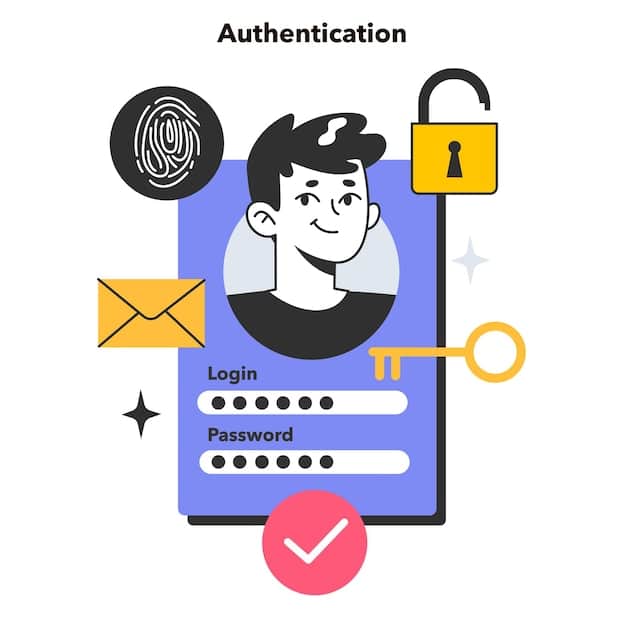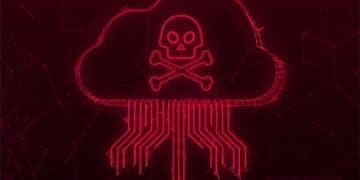Reduce Phishing Success by 40% with Multi-Factor Authentication

Multi-factor authentication (MFA) can significantly reduce the success rate of phishing attacks by adding extra layers of security, requiring users to verify their identity through multiple methods beyond just a password, enhancing overall cybersecurity.
Phishing attacks remain a prevalent and dangerous threat in the digital landscape, but implementing multi-factor authentication (MFA) can dramatically reduce their impact. This cybersecurity guide will show you how to reduce phishing attack success rate by 40% with multi-factor authentication: a cybersecurity guide, offering practical insights and strategies to protect your organization and personal data effectively.
Understanding the Phishing Threat Landscape
The phishing threat landscape is constantly evolving, with attackers using increasingly sophisticated techniques to deceive users. Understanding these threats is the first step in building a robust defense.
Common Phishing Tactics
Phishing attacks often involve deceptive emails, websites, or messages designed to trick individuals into revealing sensitive information. These tactics can range from impersonating legitimate organizations to creating a sense of urgency or fear.
The Impact of Successful Phishing Attacks
A successful phishing attack can have devastating consequences, including financial loss, data breaches, and reputational damage. Organizations and individuals alike must be vigilant and proactive in protecting themselves.
- Financial Losses: Phishing can lead to direct theft of funds or fraudulent transactions.
- Data Breaches: Sensitive data can be compromised, leading to identity theft and regulatory fines.
- Reputational Damage: Trust can be eroded, impacting customer relationships and brand value.
Staying informed about the current phishing tactics and understanding the potential impact of these attacks is crucial for developing effective strategies to mitigate the risks.
What is Multi-Factor Authentication (MFA)?
Multi-factor authentication (MFA) is a security system that requires more than one method of authentication from independent categories of credentials to verify the user’s identity for a login or other transaction.

The Core Principles of MFA
MFA is based on the principle that relying on a single factor of authentication, such as a password, is not sufficient to protect against modern cyber threats. By requiring multiple factors, MFA significantly reduces the risk of unauthorized access.
Types of Authentication Factors
There are several types of authentication factors used in MFA, each providing a different level of security. These factors include:
- Knowledge Factors: Something you know, such as a password or PIN.
- Possession Factors: Something you have, such as a security token or smartphone.
- Inherence Factors: Something you are, such as a fingerprint or facial recognition.
MFA enhances security by combining different types of authentication factors, making it more difficult for attackers to compromise user accounts.
How MFA Reduces Phishing Attack Success Rate
MFA acts as a significant barrier against phishing attacks. Even if an attacker manages to obtain a user’s password through phishing, they still need to bypass the additional authentication factors.
Preventing Unauthorized Access
MFA makes it substantially harder for attackers to gain unauthorized access to accounts and systems. The extra layers of verification mean that a compromised password alone is not enough to breach security.
Case Studies and Statistics
Numerous studies and real-world examples demonstrate the effectiveness of MFA in reducing phishing attack success rates. Organizations that implement MFA often see a significant decrease in successful phishing attempts.
- Microsoft: Reported a 99.9% reduction in account compromise rates with MFA.
- Google: Found that MFA blocks 100% of automated bots, 99% of bulk phishing attacks, and 66% of targeted attacks.
- Verizon DBIR: Highlights MFA as a critical control for preventing a wide range of cyber threats, including phishing.
The data clearly shows that MFA is a powerful tool in the fight against phishing, providing a robust layer of protection that significantly reduces the risk of successful attacks.
Implementing MFA: A Step-by-Step Guide
Implementing MFA involves careful planning and execution to ensure it is effective and user-friendly. Here’s a step-by-step guide to help you get started.
Step 1: Assess Your Needs
Begin by assessing your organization’s specific needs and identifying the systems and accounts that require MFA protection. This assessment should consider the sensitivity of the data and the potential impact of a breach.
Step 2: Choose the Right MFA Solution
Select an MFA solution that aligns with your needs and budget. There are many options available, ranging from hardware tokens to mobile apps. Consider factors such as ease of use, cost, and compatibility with your existing systems.
When choosing an MFA solution, it’s important to consider factors such as:
- Ease of Deployment: How easy is it to deploy and manage the MFA solution?
- User Experience: How user-friendly is the solution for your employees?
- Cost: What are the upfront and ongoing costs associated with the solution?

Step 3: Deploy and Configure MFA
Once you have selected an MFA solution, deploy and configure it across your organization. Provide clear instructions and training to help users understand how to use MFA effectively.
During deployment, ensure that you:
- Enable MFA for all critical accounts and systems.
- Provide training and support for users.
- Monitor the implementation to identify and address any issues.
By following these steps, you can successfully implement MFA and significantly reduce your organization’s vulnerability to phishing attacks.
Best Practices for MFA Implementation and Usage
To maximize the effectiveness of MFA, it’s essential to follow best practices for implementation and usage. These practices can help ensure that MFA provides the strongest possible protection against phishing and other cyber threats.
User Education and Training
Educate users about the importance of MFA and how to use it correctly. Provide training on how to recognize phishing attempts and avoid common mistakes.
Selecting Strong Authentication Methods
Choose strong authentication methods that are resistant to phishing and other types of attacks. Avoid using SMS-based authentication, which is vulnerable to SIM swapping and other exploits.
Consider these strong authentication methods:
- Authenticator Apps: Generate time-based one-time passwords (TOTP) on a user’s smartphone.
- Hardware Security Keys: Provide a physical token that users must plug into their device to authenticate.
- Biometrics: Use fingerprint or facial recognition for authentication.
Regularly Review and Update MFA Settings
Regularly review and update your MFA settings to ensure they are aligned with your organization’s security policies and industry best practices. Stay informed about the latest threats and vulnerabilities, and adjust your MFA configuration accordingly.
By following these best practices, you can ensure that MFA provides the strongest possible protection against phishing attacks and other cyber threats, safeguarding your organization’s data and reputation.
Overcoming Challenges in MFA Adoption
Despite the benefits of MFA, organizations may face challenges in adopting and implementing it. Understanding these challenges and how to overcome them is crucial for successful MFA deployment.
User Resistance
Some users may resist MFA due to concerns about convenience or complexity. Address these concerns by providing clear explanations of the benefits of MFA and offering training and support to help users adapt to the new system.
Integration Issues
Integrating MFA with existing systems can be challenging, especially in complex IT environments. Plan carefully and work with experienced professionals to ensure a smooth and seamless integration.
Managing MFA in Remote Work Environments
With the rise of remote work, managing MFA can be more complex. Ensure that remote workers have the necessary tools and support to use MFA effectively, and consider implementing additional security measures to protect against remote access threats.
Addressing these challenges requires a proactive and strategic approach, including clear communication, thorough planning, and ongoing support. By overcoming these obstacles, organizations can successfully deploy MFA and realize its full potential in reducing phishing attack success rates.
| Key Point | Brief Description |
|---|---|
| 🛡️ MFA Basics | Uses multiple verification methods to confirm user identity. |
| 📉 Reduces Phishing | Even if passwords are stolen, attackers need more factors. |
| 🛠️ Implementation | Assess needs, choose solutions, and provide user training. |
| 🔑 Best Practices | Educate users, update settings, and select strong methods. |
Frequently Asked Questions (FAQ)
▼
Multi-factor authentication (MFA) is a security process that requires users to provide two or more verification factors to gain access to an account, enhancing security beyond just a password.
▼
MFA adds extra layers of security, so even if a phisher steals a password, they still need to bypass additional authentication factors like codes from authenticator apps.
▼
Authentication factors include something you know (password), something you have (security token), and something you are (biometrics), each providing a different level of security.
▼
Challenges include user resistance, integration issues with existing systems, and managing MFA in remote work environments, all requiring careful planning and support.
▼
User education is crucial to ensure users understand how to use MFA correctly and recognize phishing attempts, helping to prevent common mistakes and maximize security.
Conclusion
Implementing multi-factor authentication is a highly effective strategy for reducing the success rate of phishing attacks. By understanding the phishing threat landscape, implementing robust MFA solutions, and following best practices, organizations and individuals can significantly enhance their cybersecurity posture and protect against data breaches and financial losses.





